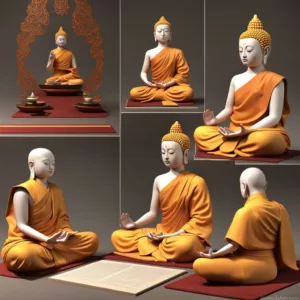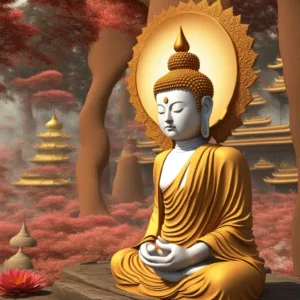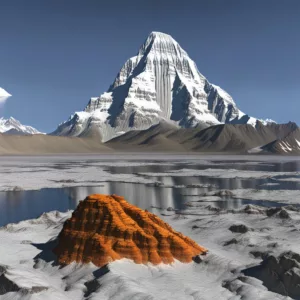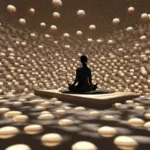
The wheel of life is a graphic representation of the 6 realms of existence, according to the Budhha.
Each level of the circle represents a layer within existence – Cognitive, emotional, realm, and karmic.
Components of the Wheel of Life
| Component | Description |
|---|---|
| Center | Three Poisons |
| Ignorance (Pig) | Represents delusion and misunderstanding of the true nature of reality. |
| Hatred (Snake) | Symbolizes anger and aversion, which lead to harmful actions and suffering. |
| Desire (Rooster) | Reflects attachment and craving, driving the cycle of samsara. |
| Second Layer | Karma |
| Ascending Beings | Depicts beings experiencing positive karma, moving towards more favorable rebirths. |
| Descending Beings | Shows beings experiencing negative karma, moving towards less favorable rebirths. |
| Third Layer | Six Realms of Samsara |
| God Realm | Realm of pleasure and luxury, but marked by ignorance of impermanence. |
| Demigod Realm | Realm of envy and constant struggle for power. |
| Human Realm | Realm of balance between pleasure and suffering, offering the best chance for enlightenment. |
| Animal Realm | Realm of ignorance and instinctual living, driven by survival. |
| Hungry Ghost Realm | Realm of insatiable desires and unfulfilled cravings. |
| Hell Realm | Realm of intense suffering and torment due to past negative karma. |
| Outer Rim | Twelve Links of Dependent Origination |
| Ignorance | Lack of understanding of the true nature of reality. |
| Formations | Mental formations and volitional actions conditioned by ignorance. |
| Consciousness | Awareness arising from mental formations. |
| Name and Form | Development of body and mind, personal identity. |
| Six Senses | Emergence of the six sense bases (sight, sound, smell, taste, touch, and mind). |
| Contact | Interaction between the senses and the external world. |
| Feeling | Sensations of pleasure, pain, or neutrality arising from contact. |
| Craving | Desire for pleasurable experiences and aversion to painful ones. |
| Clinging | Intense attachment to desires and possessions. |
| Becoming | Process leading to the formation of a new existence. |
| Birth | Entry into a new life. |
| Old Age and Death | The inevitable decline and end of life, completing the cycle of samsara. |
This table encapsulates the key components of the Wheel of Life, providing a structured overview of its intricate symbolism and the profound teachings it conveys.
Also see: samsara in Buddhism
Secrets of Meditation for Anxiety
Like millions of people, you may have suffered from anxiety for years. Meditation, yoga, peaceful music – it never works. It takes too long, and it’s not stable. Why? Because peace is treated as a cause for freedom, but it’s not – it’s the result. The cause to free yourself from anxiety is completely different.
Click now to Overcome Anxiety for good.
Table of Contents
the Wheel of Life: Map of Samsara
Introduction
“All conditioned things are impermanent. They are phenomena subject to birth and death.” This timeless wisdom, central to Buddhist teachings, is vividly illustrated in the Wheel of Life, or Bhavachakra. For over three decades, I’ve delved into this profound symbol through solitary retreats and hundreds of group sessions. Each encounter with the Wheel deepens my understanding of the cycles that bind us to samsara, the continuous cycle of birth, death, and rebirth.
In this post, we’ll unravel the intricate layers of the Wheel of Life, exploring its origins, symbolism, and the lessons it offers. Whether you’re a seasoned practitioner or new to these teachings, this journey promises to offer insights that resonate deeply with our shared human experience.
Section 1: Origins and Significance
The Wheel of Life is not merely a decorative piece of Buddhist art; it’s a visual teaching tool that encapsulates the essence of Buddhist philosophy. Its origins are traced back to the teachings of the Buddha, who used the Wheel to explain the nature of samsara and the path to liberation. The earliest depictions date back to ancient India, where monks would draw the Wheel on the ground to aid in their teachings.
The Wheel is rich in symbolism. At its core, it illustrates the fundamental Buddhist concept that life is cyclic, bound by the laws of karma and driven by the three poisons: ignorance, hatred, and desire. Surrounding the center, various realms and stages of existence depict the myriad ways beings experience suffering.
I recall a particularly poignant moment from a retreat years ago. We were deep in the mountains, with nothing but the sound of the wind and the teachings to guide us. One evening, as the sun set, our teacher unfurled a large scroll of the Wheel of Life. The vivid imagery and the serene yet urgent explanation offered a profound clarity that words alone often fail to convey. This ancient diagram suddenly felt incredibly relevant, a mirror reflecting our own struggles and aspirations.
Understanding the Wheel of Life isn’t an abstract exercise; it’s a deeply personal journey. Each element of the Wheel can serve as a mirror, reflecting our actions, thoughts, and their consequences. As we navigate through its layers in the following sections, remember that this isn’t just a teaching; it’s a map guiding us towards greater awareness and ultimately, liberation.
Next, we’ll delve into the very heart of the Wheel, where the three poisons spin the cycle of samsara.
How to meditate like a yogi
and enter profound samadhi
Section 2: The Center of the Wheel
At the heart of the Wheel of Life lies a trio of creatures—pig, snake, and rooster—entwined in a perpetual dance. These animals symbolize the three poisons that fuel the cycle of samsara: ignorance, hatred, and desire. The pig, representing ignorance, is at the root of this triad. Ignorance blinds us to the true nature of reality, keeping us trapped in delusion. The snake, embodying hatred, coils around the pig, ready to strike at anything perceived as a threat. Finally, the rooster, symbolizing desire, clutches at what it craves, never satisfied, always yearning.
These three poisons are not just abstract concepts; they are very real forces that shape our everyday lives. Reflecting on my years of meditation, I see how these poisons have manifested in countless subtle and not-so-subtle ways. In one particularly challenging retreat, I spent days wrestling with a surge of anger that seemed to come from nowhere. It was only through deep introspection and guidance from my teacher that I recognized it as an embodiment of the snake, my anger stemming from a deep-seated fear and misunderstanding.
Understanding these poisons is crucial because they are the root cause of our suffering. By identifying and working to overcome ignorance, hatred, and desire, we can begin to break the cycle of samsara. This is not an easy task—it requires vigilance and relentless honesty with oneself. Yet, it is a transformative process. Every small victory over these poisons brings us a step closer to liberation.
Section 3: The Second Layer – Karma
Encircling the three poisons, the second layer of the Wheel of Life depicts beings ascending and descending, illustrating the law of karma. Karma, the law of cause and effect, governs the cycle of rebirths. Our actions—wholesome or unwholesome—determine our future existences. Positive actions, rooted in wisdom and compassion, elevate us towards more favorable rebirths. Negative actions, driven by the three poisons, pull us into realms of greater suffering.
This layer of the Wheel serves as a potent reminder of our interconnectedness and the impact of our actions. I remember vividly a group retreat where we delved deeply into the teachings of karma. One participant, struggling with the concept, shared a personal story of how a small act of kindness had rippled out, leading to unexpected positive outcomes in his life. This sharing sparked a powerful discussion on how even the smallest actions can have far-reaching consequences, reinforcing the importance of mindfulness in our daily lives.
In my own practice, the understanding of karma has been a guiding light. It has helped me see the profound interconnectedness of all beings and the importance of living ethically. By being mindful of our actions, speech, and thoughts, we can cultivate positive karma, which not only benefits our future lives but also creates a ripple effect of goodness in the world.
The interplay of karma is intricate and nuanced. It is not a simple system of reward and punishment but a complex web of causes and conditions. Recognizing this helps us to approach life with humility and a sense of responsibility. As we move through the Wheel, we will see how karma shapes our journey through the six realms of existence, each realm offering its own lessons and challenges.
Section 4: The Six Realms of Samsara
Surrounding the layer of karma, the Wheel of Life illustrates the six realms of samsara, where beings are reborn based on their actions. These realms are more than metaphors; they represent distinct states of existence and consciousness, each with its own unique challenges and forms of suffering.
- God Realm: The realm of gods is marked by pleasure and luxury. However, these beings are blinded by their own bliss and often fail to see the impermanence of their state. Their ignorance of the transient nature of pleasure eventually leads to suffering.
- Demigod Realm: Demigods, or Asuras, are consumed by jealousy and the constant struggle for power. They are often engaged in conflicts with the gods, driven by envy and a desire for more. This ceaseless competition creates suffering and unrest.
- Human Realm: The human realm, though filled with suffering, is considered the most fortunate because it offers the greatest opportunity for enlightenment. Humans experience a balance of pleasure and pain, allowing them to cultivate wisdom and compassion.
- Animal Realm: Animals suffer from ignorance and constant fear. Their lives are driven by basic instincts and survival, leaving little room for spiritual development. The suffering in this realm stems from the lack of awareness and higher understanding.
- Hungry Ghost Realm: Hungry ghosts are tormented by insatiable desires and unfulfilled cravings. They are depicted with large stomachs and tiny mouths, symbolizing their constant hunger and inability to satisfy their needs. This realm represents the extreme end of desire and attachment.
- Hell Realm: The hell realm is characterized by intense suffering and torment. Beings here endure various forms of pain and torture, reflective of the negative karma accumulated in past lives. This realm illustrates the consequences of hatred and harmful actions.
Each of these realms offers a vivid picture of how different actions and states of mind can shape our experiences. I contemplate the realms in a casual manner quite often. I find it helpful to keep me on the path.
Section 5: The Outer Rim – The Twelve Links of Dependent Origination
Encircling the six realms is the outer rim of the Wheel, which depicts the Twelve Links of Dependent Origination. These links represent the chain of causes and conditions that perpetuate the cycle of samsara. Understanding these links is key to unraveling the nature of existence and breaking free from the cycle of birth and death.
- Ignorance: The root of the chain, ignorance obscures the true nature of reality.
- Formations: Ignorance gives rise to mental formations, which shape our actions and karma.
- Consciousness: Formations influence consciousness, leading to a sense of individuality.
- Name and Form: Consciousness gives rise to mind and body, the basis of personal identity.
- Six Senses: Name and form lead to the development of the six sense bases (sight, sound, smell, taste, touch, and mind).
- Contact: The senses engage with the external world, leading to contact.
- Feeling: Contact produces feelings of pleasure, pain, or neutrality.
- Craving: Feelings give rise to craving, the desire for pleasant experiences and the aversion to unpleasant ones.
- Clinging: Craving leads to clinging, an intense attachment to desires and possessions.
- Becoming: Clinging conditions the process of becoming, leading to future existences.
- Birth: Becoming culminates in birth, the start of a new life.
- Old Age and Death: Birth inevitably leads to aging and death, completing the cycle of samsara.
One evening, while teaching a group of students, I illustrated these links with a simple chain. As I added each link, I explained how they interconnect, showing that breaking even one link can disrupt the entire cycle. This tangible demonstration brought clarity and a sense of urgency to their practice.
The Twelve Links teach us that our present circumstances are the result of past actions and conditions. By understanding this chain, we gain insight into how to transform our future. Mindfulness and meditation allow us to observe these processes in real-time, providing the wisdom needed to break free from samsara. Recognizing these patterns in our own lives is a profound step toward liberation.
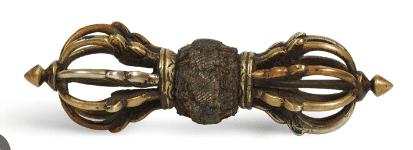


Section 6: Breaking Free from the Wheel
To break free from the Wheel of Life and the cycle of samsara, we must follow the path to liberation laid out by the Buddha. Central to this journey is the Noble Eightfold Path, which provides a comprehensive guide for ethical conduct, mental discipline, and wisdom.
- Right Understanding: Seeing the world as it truly is, understanding the Four Noble Truths, and recognizing the nature of suffering and its causes.
- Right Intent: Cultivating a commitment to ethical and mental self-improvement.
- Right Speech: Speaking truthfully, avoiding lies, gossip, and harmful language.
- Right Action: Conducting oneself ethically, avoiding harm to others, and living a life of compassion and integrity.
- Right Livelihood: Choosing a profession that does not cause harm and is ethically sound.
- Right Effort: Diligently working to develop and maintain wholesome qualities and to prevent and overcome unwholesome ones.
- Right Mindfulness: Developing awareness of body, feelings, mind, and mental phenomena, cultivating presence and attentiveness.
- Right Concentration: Practicing meditation to develop a focused, tranquil, and insightful mind.
Mindfulness and meditation play a crucial role in this path. They help us observe the three poisons within ourselves and understand the workings of karma and the Twelve Links of Dependent Origination. This awareness is transformative. It’s like turning on a light in a dark room; suddenly, we can see the obstacles and pathways clearly.
During one of my long solitary retreats, I experienced a profound shift in understanding while meditating on the Noble Eightfold Path. It wasn’t a sudden epiphany but a gradual realization that each step on the path was interwoven with the others. The integrity of the path came alive in my practice, revealing that ethical living, mindfulness, and wisdom are not separate pursuits but parts of a cohesive whole.
Breaking free from the Wheel of Life is not an instant achievement but a gradual process of self-discovery and transformation. It’s a journey of cultivating mindfulness, ethical conduct, and deep insight. Each step we take on this path brings us closer to liberation, offering glimpses of the profound peace and freedom that lie beyond samsara.
Conclusion
The Wheel of Life, with its intricate layers and profound symbolism, offers a comprehensive map of the human experience. It vividly depicts the cycles of suffering that bind us to samsara and the path to liberation that lies beyond. Understanding this ancient teaching is not merely an intellectual exercise but a deeply personal and transformative journey.
Reflecting on the three poisons at the center of the Wheel, we see how ignorance, hatred, and desire drive our actions and shape our existence. The law of karma, illustrated in the second layer, reminds us of the far-reaching consequences of our actions. The six realms of samsara depict the diverse states of suffering we can experience, while the Twelve Links of Dependent Origination unravel the complex chain of causes and conditions that perpetuate our existence.
Breaking free from this cycle requires a committed practice of the Noble Eightfold Path, integrating ethical conduct, mental discipline, and wisdom. Through mindfulness and meditation, we gain the clarity to see the true nature of reality and the courage to transform our lives.
As we conclude this exploration, I encourage you to reflect on your own life. How do the teachings of the Wheel of Life resonate with your experiences? What steps can you take today to cultivate greater awareness and compassion? Remember, the journey towards liberation is a path we walk together, each step bringing us closer to a profound peace and freedom.
For those seeking deeper understanding and practice, I invite you to join one of our upcoming retreats. These immersive experiences offer a supportive environment to delve into these teachings, guided by seasoned practitioners. Together, we can explore the Wheel of Life, not just as a symbol, but as a living practice that transforms our lives.
Additional Resources
- Books and Articles: For further reading, I recommend “The Tibetan Book of Living and Dying” by Sogyal Rinpoche and “The Wheel of Life” by His Holiness the Dalai Lama.
- Meditation Practices: Explore specific meditation practices focused on mindfulness of the body, feelings, and mental phenomena to deepen your understanding.
- Retreat Information: For those interested in a more immersive experience, join one of our upcoming retreats where we delve deeper into these teachings in a supportive and contemplative setting.
Embarking on this journey, let the Wheel of Life be your guide, illuminating the path to greater awareness, compassion, and ultimately, liberation.

May all beings be happy
May all beings be peaceful
May all beings be safe
May all beings awaken to the light of their true nature
May all beings be free

